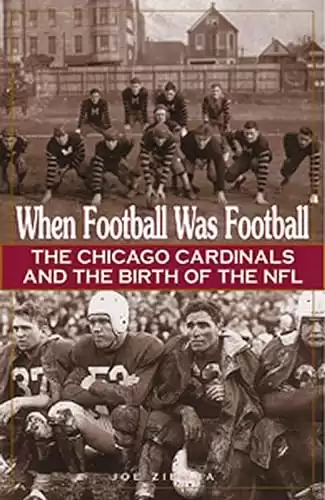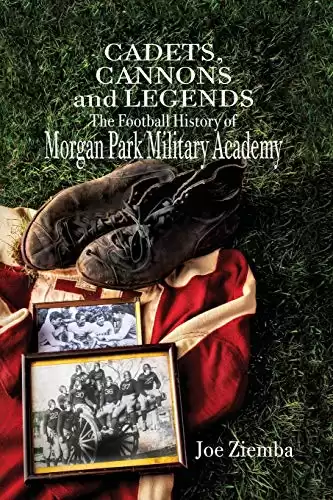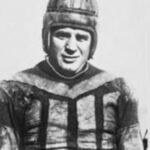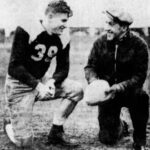Tuesday, October 18, 1938, was one of the most unique days in the history of Hammond, IN.
Nestled in the northeast corner of the state, the solidly blue-collar metropolis of Hammond is actually closer to downtown Chicago than many of the windy city’s far-flung suburbs. Yet as close as it resides to Chicago, the two cities are worlds apart.
On this episode of “When Football Was Football,” here on the Sports History Network, we’ll return to that night in Hammond when both George Halas and First Lady Eleanor Roosevelt visited at the same time and both were competing for the attention of the local residents!
You may have heard of Hammond…
It is the setting for the beloved film, A Christmas Story (called Hohman in the movie), and is the cozy next-door neighbor of notorious Calumet City, IL, a favorite hiding place for infamous Chicago underworld mobsters in the 1920s and 30s. Cal City was also the fictional location of the orphanage that needed to be saved in the Blues Brothers movie (“We’re on a mission from God…”).
Football fans may recall that the Hammond Pros were one of the original members of the American Professional Football Conference (APFC) in 1920, which quickly evolved into the National Football League.
While the Hammond Pros failed to survive much past those early years in the NFL, the city continued to staunchly support competitive sports activity, from basketball to prize fighting (boxer Battling Nelson), to local football.
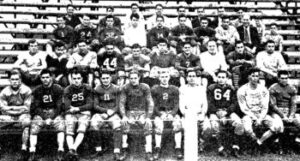
Calumet Indians Emerge
One of the more intriguing teams to emerge from the back streets of Hammond was the Calumet Indians. In fact, different reincarnations of this club utilized a variety of names such as the Calumet Gunners, the Calumet All-Stars, and the Panthers.
Although the Indians participated in several leagues over the years, perhaps they are best known (and recognized) for their efforts in the American Professional Football League in the 1930s. As with most “minor” professional leagues of the era, teams came and went rapidly and often disappeared into obscurity, alone and forgotten forever.
However, one superb advantage in retrieving the history of any Hammond professional team is the legacy left by the extensive newspaper coverage by the Hammond Times.
This was a daily newspaper, which actually published morning and afternoon editions under several local banners (e.g. Lake County Times, the Munster Times, etc.). As such, tracing the elusive history of the Calumet Indians proved challenging, but not inconvenient.
Eleanor Roosevelt and George Halas Visit
But back to October 18, 1938…
On that memorable day in Hammond history, two American icons visited the city: First Lady Eleanor Roosevelt, and, George Halas, and the Chicago Bears of the NFL.
Although the Bears and the Indians tangled in a charity game played in a driving rainstorm on (ironically) Roosevelt Field in nearby East Chicago, the unflappable Mrs. Roosevelt spoke on “The Individual and the Community” in the dry and comfortable confines of the Hammond Civic Center.
In truth, various renditions of the Calumet Indians floated around in what is known as the Calumet region of northern Indiana for many seasons. However, in particular, the 1938 version seemed to exemplify the grassroots intentions of the citizens to keep professional football alive in the city.
Players From Notre Dame and St. Ambrose
The 1938 team itself was very strong and quite capable of competing against all levels of post-collegiate competition typical during this time period. The players were recruited from a wide variety of institutions ranging from Notre Dame and Ohio State to Bethel and tiny St. Ambrose in Iowa.
Directing this crew was the robust Fred Gillies, a former player (1920-26, 1928) and coach (1928) of the Chicago Cardinals in the NFL. Gillies himself hailed from Chicago before attending Cornell University. He was also currently employed by Inland Steel as the assistant general manager. It was a huge undertaking for Gillies to take on both jobs at the same time.
In the same issue of the Hammond Times, one could read about Gillies reporting on the production status at Inland Steel, while also commenting about the status of his football team’s front line!
Gridders Unable To Practice
Tryouts for the 1938 edition of the Calumet Indians began on August 23 at Roosevelt Field in nearby East Chicago, IN.
Gillies needed to develop a cohesive and responsive line-up from a divergent group of players from a wide variety of football backgrounds. One conflict off the field impeded the efforts of Gillies as well, according to the Times: “Many former university gridders have been unable to attend practice due to shifts in working hours.”
Practices were held at Roosevelt Field on Tuesday, Wednesday, and Thursday of each week in preparation for the league opener on October 2nd against American Professional Football League (APFL) foe, the St. Louis Gunners.
Probably the most insightful article on the Hammond team as well as the APFL appeared in just the second issue of “The Coffin Corner” published in 1979 by the Professional Football Researchers Association (PFRA). Author Bob Braunwart examined the brief history of the league, as well as the somewhat confusing genealogy of the Hammond team.
Braunwart noted that “The team was known as the Indians, Steelmen, and Panthers, and was variously described as playing for Chicago, Calumet, Indiana Harbor, and East Chicago.”
Apparently, the habit of the constantly changing team name was quite annoying to some, so a contest was held early in the 1938 season where fans could submit suggestions for re-naming the club. The lucky winner would receive a Bulova watch donated by local jeweler Irving Chayken, also the team’s treasurer.
Perhaps a winner was not selected since the contest quickly disappeared from the newspapers and a team name change was not forthcoming…
Early in the season, it was apparent that the upcoming battle with the Chicago Bears on October 18th would clearly be the highlight of the campaign. The Bears’ contest was scheduled to benefit St. Catherine’s Hospital and the Hammond Times quickly proclaimed that “A crowd of 14,000 is expected to witness the game.”
Gillies Is Confident
On October 17, the Times wrote: “Gillies is confident that the team will provide more thrills and give the Bears a harder battle than any of the previous squads, which have played the Chicagoans the last three years.”
Gillies was indeed confident in his team stating: “I feel that this year’s team is the strongest we’ve had.” But he was also realistic about the Indians’ chances of success due to his own extensive experience in the NFL–meaning: minor league teams typically, if not always, had absolutely no chance to defeat an NFL club.
By October 18, the Bears were 4-1 on the season with the best record in the NFL, while the Indians were 2-0 after impressive routs of both the St. Louis Gunners and the Nashville Rebels. Maybe the Hammond fans had a small glimmer of hope that the Bears might not take the game seriously, especially after defeating the rugged Chicago Cardinals 34-28 two days previously. Would coach George Halas treat this event as merely a practice session for his reserves and leave the stars of the team at home?
Instead, Halas was taking the game quite seriously and brought a full squad to Hammond, including future Hall of Fame linemen Joe Stydahar, George Musso, and Danny Fortman. The Indians responded with a seasoned roster pulled from 25 different colleges, all of whom were anxious to challenge the mighty Chicago Bears. The Hammond Times reported:
“To match this powerful aggregation, the Indians will offer several former college stars who have been impressive in the two games Coach Fred Gillies’ team has played thus far.”
Included in that number were Purdue guard Andy Grant and Stan Mondala of Missouri. Both were both members of the 1938 College All-Star squad which defeated the Washington Redskins 28-16 in that annual contest.
Berwanger Played In 1937
In the backfield, Gillies could rely on former Alabama halfback Jimmie Angelich and Illinois back Jack Craven. The previous season, for this same exhibition game, Gillies had managed to coax Jay Berwanger to play for the Indians.
Berwanger was the first winner of the Heisman Trophy as well as the very first pick in the initial NFL draft held in 1936. However, Berwanger and George Halas of the Chicago Bears could not reach an agreement on a contract and Berwanger never played a down in the National Football League.
Jay Berwanger saw just limited action and was not a factor in the exhibition battle in 1937, but it marked his only post-collegiate appearance since the 1936 College All-Star game.
Ticket sales were brisk and, as mentioned, 14,000 were expected to be sold to benefit St. Catherine’s Hospital. Yet as the game grew closer, the threat of rain and the much-anticipated appearance of Eleanor Roosevelt on the same day of the contest could hinder attendance.
The first lady’s lecture would take place at the Hammond Civic Center and the Hammond Times naturally promoted this event as well. While the Bears dominated the talk on the first page of the sports section, Mrs. Roosevelt was the primary subject on the first page of the newspaper!
It was explained that the speaker would be aided by 18 Hammond policemen, not so much for safety reasons, but to “keep publicity seekers and too ardent admirers from marring Mrs. Roosevelt’s visit.”
Bears Shocked By Indians!
On the evening of October 18, there were 5,000 on hand to hear the message of Mrs. Roosevelt at the Hammond Civic Center, while the Chicago Bears attracted 7,000 in a steady rain at Roosevelt Field. While the speech of Mrs. Roosevelt provided no surprises, the Bears received quite a shock when the Indians were ahead of the heralded Chicagoans 6-2 at the half.
This was totally unexpected according to the Hammond Times: “Coach Fred Gillies’ team showed plenty of class in marching to its touchdown and holding a slim four-point lead over the mighty Chicagoans in the first half.”
Bears Turned On The Power
The somewhat unbelievable halftime score prompted the visitors to pull out all of their gridiron weapons in the second half. The Hammond Times stated: “The Bears were compelled to turn on the power in the second half to win the game.
They scored four touchdowns in their favorite spectacular manner, two of them on long runs. Terrific pounding by the Bears and lack of substitutes, however, eventually proved disastrous [for the Indians].”
The second-half outburst, including an 85-yard scoring run by Bob Swisher, allowed the Bears to escape with an easy 29-6 victory. Overall, a tidy sum was raised for St. Catherine’s Hospital, the fans went home happy, and the Chicago Bears returned to NFL competition, struggling down the stretch to finish with a 6-5 record for 1938.
Meanwhile, the Calumet Indians grabbed the regular season crown of the American Professional Football League with a 5-1 mark but fell to the Louisville Tanks 13-0 in the playoffs.
If you’re keeping track at home, you’ll note that George Halas and the Bears attracted a few more attendees than did First Lady Eleanor Roosevelt. But on this special night for the city of Hammond, IN, no one was counting!
Please join us next time on the Sports History Network when we share a mysterious story about the legendary Red Grange of the Chicago Bears. Picture a dark, sweaty gym in Chicago where Grange was overseeing a workout by one of his teammates. Suddenly, a smartly dressed young man slithers into the room and asks to speak to Grange. An autograph seeker?
Not this time, for the young man, was “Machine Gun” Jack McGurn, one of the more notorious gangsters in the city of Chicago. What did he want with Red Grange? Find out next time on “When Football Was Football!”
Author and Host - Joe Ziemba
Joe Ziemba is the host of this show, and he is an author of early football history in the city of Chicago. Here, you can learn more about Joe and When Football Was Football, including all of the episodes of the podcast.
Please Note – As an Amazon Associate I earn from qualifying purchases
Resources
More From When Football Was Football
Paddy Driscoll’s Almost Perfect Season
Back at the beginning of the National Football League in...
Read More120,000 Fans Witness High School Football Game in 1937!!!
Let’s set the stage… It was a warm November afternoon...
Read MoreIn The Beginning: An Interview With Joseph T. Sternaman
And, you may ask, who is Joseph T. Sternaman? Sternaman...
Read More1948: The Last Hurrah of the Chicago Cardinals
Cardinals’ fans are familiar with the long, sad story concerning...
Read More